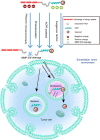The role of cell-penetrating peptides in potential anti-cancer therapy
- PMID: 35593206
- PMCID: PMC9121317
- DOI: 10.1002/ctm2.822
The role of cell-penetrating peptides in potential anti-cancer therapy
Abstract
Due to the complex physiological structure, microenvironment and multiple physiological barriers, traditional anti-cancer drugs are severely restricted from reaching the tumour site. Cell-penetrating peptides (CPPs) are typically made up of 5-30 amino acids, and can be utilised as molecular transporters to facilitate the passage of therapeutic drugs across physiological barriers. Up to now, CPPs have widely been used in many anti-cancer treatment strategies, serving as an excellent potential choice for oncology treatment. However, their drawbacks, such as the lack of cell specificity, short duration of action, poor stability in vivo, compatibility problems (i.e. immunogenicity), poor therapeutic efficacy and formation of unwanted metabolites, have limited their further application in cancer treatment. The cellular uptake mechanisms of CPPs involve mainly endocytosis and direct penetration, but still remain highly controversial in academia. The CPPs-based drug delivery strategy could be improved by clever design or chemical modifications to develop the next-generation CPPs with enhanced cell penetration capability, stability and selectivity. In addition, some recent advances in targeted cell penetration that involve CPPs provide some new ideas to optimise CPPs.
Keywords: Anti-cancer therapy; cell-penetrating peptides; molecular cargoes; optimisation; tumour immunity.
© 2022 The Authors. Clinical and Translational Medicine published by John Wiley & Sons Australia, Ltd on behalf of Shanghai Institute of Clinical Bioinformatics.
Figures






Similar articles
-
The Different Cellular Entry Routes for Drug Delivery Using Cell Penetrating Peptides.Biol Cell. 2025 Jun;117(6):e70012. doi: 10.1111/boc.70012. Biol Cell. 2025. PMID: 40490965 Free PMC article. Review.
-
Tumor microenvironment-responsive cell-penetrating peptides: Design principle and precision delivery.Colloids Surf B Biointerfaces. 2024 Oct;242:114100. doi: 10.1016/j.colsurfb.2024.114100. Epub 2024 Jul 16. Colloids Surf B Biointerfaces. 2024. PMID: 39024717 Review.
-
Cell penetration: scope and limitations by the application of cell-penetrating peptides.J Pept Sci. 2014 Oct;20(10):760-84. doi: 10.1002/psc.2672. Epub 2014 Aug 11. J Pept Sci. 2014. PMID: 25112216 Review.
-
[Advances in the research and application of cell penetrating peptides].Sheng Wu Gong Cheng Xue Bao. 2019 Jul 25;35(7):1162-1173. doi: 10.13345/j.cjb.190030. Sheng Wu Gong Cheng Xue Bao. 2019. PMID: 31328473 Review. Chinese.
-
Current Delivery Strategies to Improve the Target of Cell Penetrating Peptides Used for Tumor-Related Therapeutics.Curr Pharm Des. 2018;24(5):541-548. doi: 10.2174/1381612823666170728094922. Curr Pharm Des. 2018. PMID: 28758600 Review.
Cited by
-
Targeting the 'Undruggable' Driver Protein, KRAS, in Epithelial Cancers: Current Perspective.Cells. 2023 Feb 15;12(4):631. doi: 10.3390/cells12040631. Cells. 2023. PMID: 36831298 Free PMC article. Review.
-
Progress of nanoparticle drug delivery system for the treatment of glioma.Front Bioeng Biotechnol. 2024 Jun 11;12:1403511. doi: 10.3389/fbioe.2024.1403511. eCollection 2024. Front Bioeng Biotechnol. 2024. PMID: 38919382 Free PMC article. Review.
-
Genomic dissection and mutation-specific target discovery for breast cancer PIK3CA hotspot mutations.BMC Genomics. 2024 May 27;25(1):519. doi: 10.1186/s12864-024-10368-1. BMC Genomics. 2024. PMID: 38802751 Free PMC article.
-
A Computational Predictor for Accurate Identification of Tumor Homing Peptides by Integrating Sequential and Deep BiLSTM Features.Interdiscip Sci. 2024 Jun;16(2):503-518. doi: 10.1007/s12539-024-00628-9. Epub 2024 May 11. Interdiscip Sci. 2024. PMID: 38733473
-
Progress and prospect of polysaccharides as adjuvants in vaccine development.Virulence. 2024 Dec;15(1):2435373. doi: 10.1080/21505594.2024.2435373. Epub 2024 Dec 5. Virulence. 2024. PMID: 39601191 Free PMC article. Review.
References
Publication types
MeSH terms
Substances
LinkOut - more resources
Full Text Sources
Other Literature Sources
Medical
